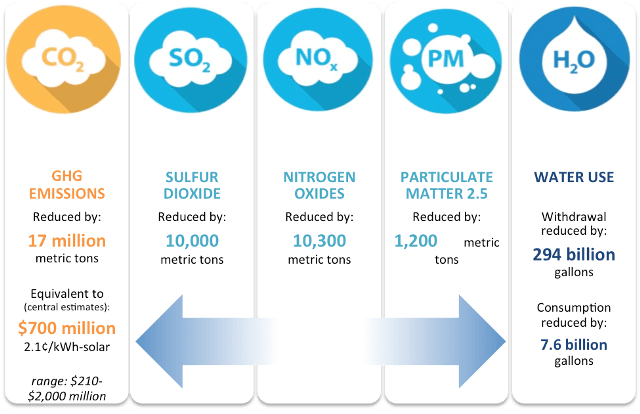May 19 2016
According to a research from the U.S. Department of Energy (DOE)’s Lawrence Berkeley National Laboratory (Berkeley Lab) and National Renewable Energy Laboratory (NREL), solar power could give rise to $400 billion in public health and environmental benefits across the US by 2050.
 These are annual environmental and health benefits of the 20 GW of solar power installed by the end of 2014. (Credit: Berkeley Lab)
These are annual environmental and health benefits of the 20 GW of solar power installed by the end of 2014. (Credit: Berkeley Lab)
“We find that a U.S. electric system in which solar plays a major role—supplying 14% of demand in 2030, and 27% in 2050—would result in enduring environmental and health benefits. Moreover, we find that the existing fleet of solar plants is already offering a down-payment towards those benefits, and that there are sizable regional differences in the benefits,” said Ryan Wiser, Berkeley Lab’s Energy Technologies Area.
Based on central assumptions, the total economic value of the greenhouse-gas (GHG) and air pollution profits of the high-penetrating solar scenario is higher than $400 billion in present-value conditions. Focusing on the present end-of-2014 convoy of solar power projects, current annual benefits are equal to over $1.5 billion based on central assumptions.
The report, titled, The Environmental and Public Health Benefits of Achieving High Penetrations of Solar Energy in the United States is part of a series of papers published, as part of the U.S. Department of Energy’s On the Path to SunShot project.
The SunShot Initiative was launched by DOE in 2011, with the aim of reducing the cost of solar energy such that by the end of the decade, it is cost-competitive with various forms of electricity. The latest reports consider the progress made so far, and emphasize a variety of barriers and opportunities that continue to achieve SunShot-level price reductions.
The aim of SunShot Initiative is to reduce the installed price of solar by as much as 75% between the period of 2010 and 2020. In the SunShot Vision Study which was published in 2012, DOE discovered that meeting the cost effective solar goal of SunShot could lead to solar energy supplying 14% of U.S. electricity requirement by 2030 and 27% by 2050.
The current study monitors that work by checking the GHG emissions reductions, water usage reductions, and air-pollution environmental and health impacts from huge amounts of solar energy.
This study augments the original DOE report by attaching specific numbers to the benefits of solar energy. It also assesses the benefits already being delivered by the existing fleet of solar projects. Importantly, we take great care to describe our methods and highlight underlying uncertainties.
Trieu Mai, NREL
Advantages of the Current Fleet of Solar Projects
The research finds that 20GW of solar deployed by the end of 2014 is lowering yearly GHGs already by 17 million metric tons, costing around $700 million per year if prized with a central approximation of the “social cost of carbon” – the Obama Administration’s estimate of the long-standing harm done by a single ton of carbon emissions. More than half of these benefits arise from emissions reduction in California.
Solar is also decreasing traditional air pollutants from power plants –nitrogen, sulfur, and particulates; and the resultant health benefits are largest in the eastern US. On the whole, the environmental and health benefits of this reduction in pollution are worth about $890 million right from preventing mortality of premature babies to a variety of other negative health outcomes.
The East has more coal-fired power generation than the rest of the country, and therefore sees greater benefits in reducing conventional pollutants.
Ryan Wiser
Advantages from a High-Penetration Solar Energy Future
Looking ahead further, with solar expanding to 14% of demand by 2030 and 27% by 2050, this research proposes GHG reductions by as much as 13% and 18% in 2030 and 2050, respectively, in comparison to a scenario of no additional solar. These reductions in emission are worth around $259 billion in decreased global climatic damages on the basis of central estimates, or 2.2 cents/kWh of solar.
Striking SunShot goals is also found to decrease nitrogen, sulfur, and particulate emissions, giving $167 billion in environmental and health benefits, or 1.4 cents/kWh of solar, once more based upon central estimates. Decreasing premature mortality from sulfate particles offers the most prominent advantage. Accomplishing the SunShot Vision scenario can decrease premature mortalities in between 25,000 and 59,000 lives, on the basis of methods created by the U.S. Environmental Protection Agency.
Finally, solar power decreases water usage by power plants. In comparison to the baseline scenario, accomplishing the SunShot Vision scenario decreases power-sector water withdrawals by 8% and 5% in 2030 and 2050, respectively, whereas consumption of water is decreased by 10% and 16% in 2030 and 2050, respectively. Significantly, sunny but drought-prone states, and arid like Texas and California, are amongst those with the greatest reductions in water usage.
The U.S. Department of Energy SunShot Initiative supported the research.